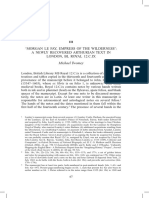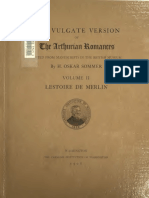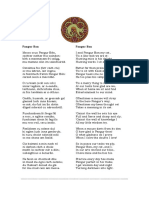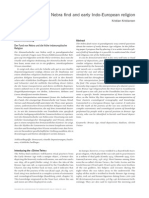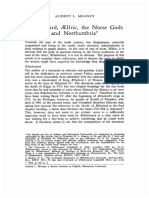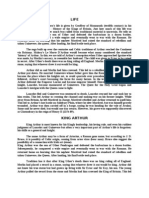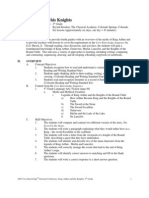Nymue, The Chief Lady of The Lake, in Malory's Le Morte Darthur
Nymue, The Chief Lady of The Lake, in Malory's Le Morte Darthur
Uploaded by
bluesapphire18Copyright:
Available Formats
Nymue, The Chief Lady of The Lake, in Malory's Le Morte Darthur
Nymue, The Chief Lady of The Lake, in Malory's Le Morte Darthur
Uploaded by
bluesapphire18Original Description:
Original Title
Copyright
Available Formats
Share this document
Did you find this document useful?
Is this content inappropriate?
Copyright:
Available Formats
Nymue, The Chief Lady of The Lake, in Malory's Le Morte Darthur
Nymue, The Chief Lady of The Lake, in Malory's Le Morte Darthur
Uploaded by
bluesapphire18Copyright:
Available Formats
Medieval Academy of America
Nymue, the Chief Lady of the Lake, in Malory's Le Morte Darthur
Author(s): S. E. Holbrook
Source: Speculum, Vol. 53, No. 4 (Oct., 1978), pp. 761-777
Published by: Medieval Academy of America
Stable URL: http://www.jstor.org/stable/2849785 .
Accessed: 30/11/2014 22:15
Your use of the JSTOR archive indicates your acceptance of the Terms & Conditions of Use, available at .
http://www.jstor.org/page/info/about/policies/terms.jsp
.
JSTOR is a not-for-profit service that helps scholars, researchers, and students discover, use, and build upon a wide range of
content in a trusted digital archive. We use information technology and tools to increase productivity and facilitate new forms
of scholarship. For more information about JSTOR, please contact support@jstor.org.
Medieval Academy of America is collaborating with JSTOR to digitize, preserve and extend access to
Speculum.
http://www.jstor.org
This content downloaded from 144.37.1.110 on Sun, 30 Nov 2014 22:15:55 PM
All use subject to JSTOR Terms and Conditions
NYMUE, THE CHIEF LADY OF THE LAKE,
IN MALORY'S LE MORTE DARTHUR
BY S. E. HOLBROOK
THE account of Merlin's disappearance fromthe world most often repeated
is thathe was imprisoned by the woman he loved afterhaving taughther all
the magic art that she desired to know. All the major versions in medieval
literature,except the Vulgate Merlin Sequel, identifythe woman in question
as the Lady of the Lake,I and all but the Propheciesde Merlinprovide another
name as well, writtenwith several spellingsthat seem to be scribalvariations
of each other.2 It has become convenient to call the Lady of the Lake
"Niniane" as she appears in the Vulgate Lancelotand the Suite du Merlin,
"Viviane" in the Vulgate Sequel, and "Nymue" in Sir Thomas Malory's Le
MorteDarthur.3As the object of Merlin's fatal love the Lady of the Lake has
achieved notoriety,but it is necessary to remind readers that she is by no
means generallyrepresentedin medieval fictionas evil and thather place in
Arthurianlegend is not confined to being the cause of Merlin's disappearance. Malory's Nymue especially does not fit the label "wiley temptress"
inevitablyapplied to Merlin's lover, and even more than her counterpartsis
worth being recognized in the fullness of the roles given her.
Although scholars have not been blind to Nymue's presence in Le Morte
Darthur,the attentionhas been incidental. Afterthe last generation of sorting out issues, Malory criticismcan now afford,among other things,to peer
at Malory's echelon of minor characters as something besides clues to
sources, chronology, biography, or unity. Those who appraise Le Morte
Darthurfor its storytellingshould benefitfrom an ampler acquaintance with
Nymue, for she is a sturdy,memorable adjunct in the supporting cast that
enriches thiswork's narrativeworld. The focus of tte present essay, then,is
Nymue, its object to define what she is like, viewed not merely in the
1 Lucy Allen Paton has argued thatthe Lady of the Lake is a Celtic fee distinctin origin from
the lover of Merlin (Studiesin theFairyMythology
ofArthurian
Romance,2nd ed. [1903; repr., New
York, 1970]); nevertheless,by the time of the earliest extant work in which either figure
appears, the Lady of the Lake is also Merlin's beloved.
2 There are over a dozen variations,ranging from "nymenche" to "uiuane"; most scholars
seem satisfiedthat all could be scribal corruptionsof each other. Although there is no manuscript authorityfor the definitiveor earliest spelling of the name, Paton and others have
accepted "Niniane" as the basic form; A. 0. H. Jarmon,however,has raised the possibilitythat
"Viviane" is the earliest form ("A Note on the PQssible Welsh Derivation of Viviane,"Gallica
[Cardiff,1969], p. 8). Paton tends to use "Niniane" as the standard name, although Gaston Paris
and Jacob Ulrich consistentlyadopt the spelling "Niviene" in theiredition of the Huth Suitedu
Merlin (Merlin [Paris, 1886]); H. Oskar Sommer consistentlyprints "uiuane" in both of his
editions of the Vulgate MerlinSequel (Le Romande Merlin[London, 1894] and Lestoirede Merlin
in The VulgateVersionof theArthurianRomances[Washington, 1908]).
3 Although the spelling "Nymue" does not occur at all in the Winchester MS of Le Morte
Darthur,it does occur four out of seven timesin William Caxton's edition, the only textfamiliar
to readers until the 1947 edition of the Winchester MS by Eugene Vinaver.
761
This content downloaded from 144.37.1.110 on Sun, 30 Nov 2014 22:15:55 PM
All use subject to JSTOR Terms and Conditions
762
Nymue,The ChiefLady of theLake
isolated, and in this case even paltry,Merlin affair,but as she appears in the
whole of Malory's Arthuriadwhetherapproached as a collectionof assorted
tales or as a unifiednarrativesequence. The firstportion takes up the sticky
problem of Nymue's names and which incidents aire properly ascribed to
her; the second portion touches upon Malory's sourtes for the passages
involvingNymue; and the thirdlooks in detail at Nymue's appearances in Le
MorteDarthur.
Several things may be learned. For one, contrary to what has been
thought,Malory has two Ladies of the Lake - not three or more, and not
one, who is now good, now bad, now dead, now alive - and one of them is
indeed Nymue. Further,we see the ways Malory,responding to a precedent
in his sources, ameliorates Nymue's part in Merlin's disappearance and
expands her role of benign helper, his changes promotingconsistencyand
continuityin line with his narrative habit overall. Finally, and especially
useful to those of us occupied with the larger legend surrounding Merlin
and the Lady of the Lake, we findthatfar frombeing the bawd of fabliau or
the femmefatale of romance, in Le MorteDarthurNymue, the Chief Lady of
the Lake, has a secure identityas the bold and helpful female who ever "dyd
grete goodenes vnto kynge Arthur and to alle his knyhtes."4
In approaching a discussion of Nymue as she appears in Malory'sLe Morte
Darthur,we must solve the problem of names before singling out which
incidentsbelong to her. Unlike other medieval narratives,where most of the
personnel tend to remain anonymous, Malory's long work abounds with
names for nearly everybody.Sometimes names which are slightlydifferent
evidentlyreferto the same character,as in the case of "Breuse saunce pyte"
and "the broune knyghtwyhtoutepyte," and sometimes names which are
veryalike evidentlyreferto differentcharacters,as in the case of "Bryan of
the Ilys" and "Bryan de les yles." And, since medieval spellings of proper
names normallytend to be inconsistent,Malory'sreader may be all the more
inclined to hesitate before recognizing who is who, relyingon epithets or
allusions to kindred and previous incidents as supportive identification.
Tracking down Nymue is additionallycomplicated because she has a second
name, "the Lady of the Lake." In short, then, one cannot assume at the
outset thateverytime the name "Nymue" or some variantthereofappears it
designates the same character,nor that every time the epithet "Lady of the
4 The edition being used for quotations from Malory is the Caxton text as reprinted by H.
Oskar Sommer,Le MorteDarthur(1889; repr., New York, 1973); passages are cited by book and
chapter only, not page. For several reasons, Malory scholars have, over the last twenty-five
years,become used to consultingthe WinchesterMS version as edited by Vinaver rather than
the Caxton version. Not everyone who has compared the two texts,however,is convinced that
the Caxton should be rejected. The present author resorts to the Caxton both by way of
convenience for Victorian scholars interestedin later Arthuriana,students,and other readers,
who are likelyto read Le MorteDarthurin editions based on Caxton, and by way of signalling
that the Caxton version should perhaps be brought out of eclipse. Quotations from Sommer's
edition have been checked against the Pierpont Morgan Library copy of Caxton.
This content downloaded from 144.37.1.110 on Sun, 30 Nov 2014 22:15:55 PM
All use subject to JSTOR Terms and Conditions
Nymue,The ChiefLady of theLake
763
Lake" occurs it designates the same character,let alone that "Nymue" and
"Lady of the Lake" both refer to the same character.
Fortunately,the spellingsof Nymue's name are not wildlydiverse. In the
Caxton text of Le Morte Darthur the name "Nymue" occurs four times,
"Nyneue" twice,and "Nynyue" once, while in the WinchesterMS the name
"Nynyve"occurs five times and "Nenyve" twice. The Caxton and Winchester, then, share only one variant, "Nynyue" or "Nynve." Interestingly,
"Nymue" is unique to the Caxton text,and although in using the letterm it is
related to the spellings "Nymyane," "Nymiane," and "Nimiame" found in
Lovelich'sMerlinand the Middle English prose translationof Merlin5- both
close in date to Le MorteDarthur- it is distinguishedby the position of the
vowel u, which evidentlypreventsit frombeing interchangeablewithv as in
the other variants. Not having ascertained the manuscriptCaxton used for
his edition,we cannot say whetheror not thisversionof the name is Caxton's
own editorial contribution.In any event,it is the name repeated most often
in the Caxton text,and since only Caxton's textof Le MorteDarthurhad been
published until 1947, Malory's readers have become accustomed to knowing
his character as "Nymue."6
Further,it is only reasonable to conclude thatin Le MorteDarthurthe name
"Nymue," or its orthographicvariants,does designate the same characterin
each instance, for the accompanying epithets and allusions all link up. Of
particularimportanceis Nymue's alias, "the Lady of the Lake." In the seven
separate incidents using the name "Nymue," six also use the epithet,
"damosel(s) of the lake," "Lady(ies) of the lake," or "chief lady of the lake."
The phrases "one of" the damosels or ladies of the lake and also "chieflady"
imply that there is someone in Le MorteDarthurbesides Nymue known as
"the Lady of the Lake," as indeed there is. This Lady of the Lake is the
woman whom Arthur sees "goyng vpon the lake" (Bk. 1, ch. 25) where her
sword Excalibur is held aloft by an emerging arm clothed in white samite.
She gives Arthur Excalibur in exchange for his promise to fulfilla future
request. A littlelater,in the tale of Balin, she comes to court to demand that
Arthur keep his promise by decapitating either Balin or a certain damosel
whose sword Balin has taken. Arthur rejects her request as unseemly, "I
maye not graunte neyther of her hedes with my worship" (Bk. 2, ch. 3),
while Balin accuses her of falsehood and treachery,declaring that she "was
the vntruestlady lyuynge/and by enchauntementand sorsseryshe hath ben
the destroyerof many good knyghtes/ and she was causer that my moder
was brente thorow her falshede and trechery."In revenge he cuts off her
head. Arthurreproaches Balin for killinga woman who was under his safe
5"Nymyane" and "Nymiane" occur in Lovelich's Merlin, "Nimiane," "Nimiame," and
"Nimyane" in the prose Merlin.
6 In fact, before Sommer's 1889 edition of Caxton's text of Le MorteDarthur,many editions
(all but Southey's and Strachey's) printed the name "Nimue" at least five times,because they
were reprintsbased not on Caxton's 1485 edition but on Wynkynde Worde's 1529 edition in
which,among other modificationstowardsconsistency,the spelling of the name also tends to be
regularized.
This content downloaded from 144.37.1.110 on Sun, 30 Nov 2014 22:15:55 PM
All use subject to JSTOR Terms and Conditions
764
Nymue,The ChiefLady of theLake
conduct and buries the Lady of the Lake nobly. Malory'sown earlier line of
exposition, "whan Balyn was redy to departe he sawe the lady of the lake
that by her menes had slayne Balyns moder," gives objectivityto Balin's
accusation; hence the surprisingterminationof her presence is justifiable
even though ignoble.
In Malory's source for these two episodes, the woman is anonymous,
merely "une damoiselle," withoutany titularconnection to a lake.7 Malory
alone gives her the name "Lady of the Lake" and then takes pains to
disassociateher fromNymue, perhaps as much because of Balin's accusation
of falsityas because she has become a moribund character. It is easy to see
whyMalory,withhis penchant for naming all characters,would have named
the giver of Excalibur as he did. Although it is not her arm that thrusts
Excalibur aloft here in a lake near Caerleon or that arises from a "water" to
retrieveExcalibur later afterthe battleon SalisburyPlain, her dwellingplace
is apparently under or near the lake, for "withinthat lake is a roche / and
therynis as fayra place as ony on erthe and rychelybesene" (Bk. 1, ch. 25),
and when Arthursees her she is, of course, "goyng vpon the lake." Further,
if Malory were already aware of the Dame du Lac as a personage in the
French romances,it musthave seemed appropriate to him to give her titleto
the source of Excalibur, Arthur's sign and implement of greatness, an
identificationwhich subsequentlyran afoul of the woman's role in the Balin
episode.8
There are four other referencesto a damosel or lady of the lake divorced
from the name "Nymue," but three of these plainly do referto Nymue and
the fourthprobably does so as well. The damosel named "Nymue" in the
adventure of Pellinor receives the additional appellation "damoysel of the
lake" in the next tale, which tells of her relationshipwith Merlin. The two
references to "the damoysel of the lake" that follow the story of Merlin's
entombmentoccur in incidents directlyconnected in plot and personnel.
Since the "damoysel of the lake" is additionallyidentifiedin the firstof these
incidents as she who "had put Merlyn vnder the stone," who, in turn, had
previouslybeen identifiedas "the damoisel that kyngPellinore broughte to
the courte / and she was one of the damoysels of the lake that hy3te
Nyneue," she obviously must be Nymue, too. Again, the "chyeflady of the
lake" who is mentionedin the "Healing of Sir Urre" must be Nymue, for on
another occasion the name "Nynyue" is conjoined with the epithet "chyef
lady of the lake," presumably to distinguishNymue from the Lady of the
Lake who had given Arthur Excalibur and had been killed by Balin. The
7"Ensi qu'il tenoient parole de l'espee, atant voient une damoisele qui venoit par de viers la
mer ... Li rois prent l'espee et moult en merchie la damoisiele" (Merlin,ed. Paris and Ulrich,
1:197-198). In the storyof Balin, "endementiersqu'il parloientpar laiens de ces choses, atant es
vous une damoisiele tout a chevel qui laiens entra ... et li rois regarde la damoisiele et connoist
que est cele qui l'espee li douna" (1:218).
8 Paton remarksthatin the "strange sequel to the storyof Arthur'sfindingof Excalibur,"it is
the "feature of the sword" that led the original author of thisepisode to merge the giver of the
sword and the fay whose death caused Balin to leave the court (pp. 199-200, nl).
This content downloaded from 144.37.1.110 on Sun, 30 Nov 2014 22:15:55 PM
All use subject to JSTOR Terms and Conditions
Nymue,The ChiefLady of theLake
765
only reference to "the lady of the lake" open to confusion is the passing
allusion, "And after that the lady of the lake confermed hym sir Launcelot
du lake," but since within both the internal chronology and the formal
structureof Le MorteDarthurthe other Lady of the Lake had died before
Lancelot was born, it is plausible to assume that Malory did have Nymue in
mind here. Further,although R. H. Wilson prefersto count thisLady of the
Lake as a third character with the same title, nothing latent in this brief
reference requires such a separation.9
Altogether, then, Nymue appears in ten distinct actions or references
spread throughoutLe MorteDarthur. In order, she takes part in the tale
involvingPellinor's adventure (Bk. 3, ch. 5, 12-15); the episode of Merlin's
infatuationand death (Bk. 4, ch. 1, 5); the stories of Arthur's battle with
Accolon and Morgan's magic mantle (Bk. 4, ch. 9-10, 16); the adventure of
Gawain, Pelleas, and Ettard (Bk. 4, ch. 23-24, 29); the Tristram section
where Arthur's life is endangered by Lady Annowre (Bk. 9, ch. 16) and
again where Galahad's enfanceis narrated (Bk. 11, ch. 3); the tale of the
poisoned apple (Bk. 18, ch. 8); the tale of the healing of Sir Urre where she
is included once as part of a previouslyuntold storyconcerning Servause le
Breuse and again in connectionwith the Pelleas affair(Bk. 19, ch. 11); and
finallyin the scene of Arthur's"dolorous deth & departyng"(Bk. 21, ch. 6).
Basically,Nymue's several appearances sort out into five kinds of parts: the
damosel who is brought to court by Pellinor, who shuts the doting Merlin
into his livinggrave, who saves and weds Pelleas, who protectsLancelot, and
who aids Arthurand his queen. Are not such partsincompatible,do theynot
cause a conflictin characterization?Surprisingly,the answer is no. Indeed,
withinthe obvious internal chronologyand narrativesequence of Le Morte
Darthur,Nymue develops withacceptable logic: initiallya damosel in distress,
transitionallya sorcerer's apprentice, finallya benevolent sorceress on the
side of good knightsand particularlyArthur'scourt. To be sure, we have a
characterwho is not cut fromwhole cloth,and the seams are visible; nevertheless, Nymue emerges as a consistentlysympatheticfigure, memorable
more as Pelleas's beloved wife than as Merlin's fatal lover.
It is informativeto begin with a general notice of Malory's sources, even
though analogous material has not been recovered for all portions of Le
Morte Darthur, nor, with the possible exception of the alliterativeMorte
have the medieval textsof Malory'sknownsources been preserved.10
Arthure,
For the early part of Le MorteDarthur,Malory used the Suitedu Merlin and
retained all four of Niviene's parts. The adventure with Pellinor and the
incidentsof Arthur'sbattle with Accolon and Morgan's mantle are basically
similar in both Malory's version and the Suite's. Malory's treatment of
Nymue's relationshipwith Merlin, however, is considerably differentfrom
9 "Addenda on Malory's.Minor Characters,"JEGP 55 (October, 1956), 580.
10For the suggestionthat Maloryused the Thornton MS copy of the alliterativeMorteArthure,
the sole version now extant,see William Matthews,The III-FramedKnight(Berkeley, 1966), pp.
99 and 213.
This content downloaded from 144.37.1.110 on Sun, 30 Nov 2014 22:15:55 PM
All use subject to JSTOR Terms and Conditions
766
Nymue,The ChiefLady of theLake
the Suite's,although related to that branch ratherthan the Vulgate Sequel's;
it reflectsan influenceby theLancelotand perhaps by the Propheciesas well.1I
The story of Gawain, Pelleas, and Ettard is also found in the Suite, but
Malory apparentlygives it a whollynew denouement in which Nymue has a
unique role. Nymue's aid to Arthur when he is beset by Annowre grows
froma mere seed in the correspondingadventure in the prose Tristanwhere
one of the Lady of the Lake's damosels is minimallyinvolved.12 The reference to the Lady of the Lake's givingLancelot his name does not, however,
seem to be in Malory'ssource for that segment of the Tristramsection.13 In
the tale of the poisoned apple, for which Malory drew upon the MortArtu,
Nymue's entire role is Malory's addition. No definitesource exists for the
healing of Sir Urre, and it remains plausible that Malory created the whole
story,certainlyat least the roll call of names in which the two allusions to
Nymue occur. The link there with Pelleas comes, of course, from Malory's
own story,while in connectingher withServause le Breuse, Malory refersto
the French book. In the littlestoryhe appends, Servause flickeringly
resemin both name and deed, for both do
bles Segurant le Brun of the Prophecies,
notjoust withLancelot thanksto promises made to the Lady of the Lake and
both are involved in exploits with dragons and giants.14 The rhetorical
device of citing spurious authority notwithstanding,Malory's vignette of
Servause and Nymue may have been sparked by a memoryof the Prophecies's
Segurant le Brun. For the scene of the ship takingArthuraway fromhis last
battle, Malory drew upon the Mort Artu and also the English stanzaic Le
MorteArthur,but the presence of Nymue among the women in the ship is
unique to his version.
In summary,then, as far as one can tell, Malory kept all four of Nymue's
parts in the Suite, one of which, the relationship with Merlin, is quite
changed; chose only one reference from the prose Tristan,which he enlarged; excluded all from the prose Lancelot;15 and added several (four to
11 The compressed nature of the episode in both the Lancelotand Malory may cast a false
resemblance between the two versions, but it is notable that only the Lancelot and Malory
explicitlyconjoin a cave and Cornwall in the locus of Merlin'simprisonment.Paton suggeststhat
"the influence of some such story as that of the Propheciesmay be at work" (p. 221).
12 "Enfin une des demoiselles de la dame du Lac lui avait 6te la bague et la'avait jetee dans
une riviere" (in the analysis of Le Roman en prosede Tristan,E[ilert] Loseth [1891; repr., New
York, 1970], p. 59, section 74a).
13 The unedited state of the numerous prose TristanMSS makes a definiteconclusion difficult
to reach. However, Sommer reports that Galahad's name is not mentioned in the parallel
passage of the French romance (Le MorteDarthur,3:192); an analogous referencedoes not occur
in the version edited by Paulin Paris, Les Romans de la table ronde, 5 (Paris, 1877); such a
reference,or even the basis for it in the relevant portion of the prose Tristan,is not noted by
either Loseth (p. 276, n5, section 388a) or Vinaver (The Worksof Sir ThomasMalory,2nd ed.
[Oxford, 1967], pp. 1524-1525.
, 14 See Les Prophecies
de Merlin,ed. Lucy Allen Paton (New York, 1926), 2:438-439 (Dame du
Lac preventsjoust between Lancelot and Segurant), 206 (pursuit of dragon), 447 (combat with
giant); for commentaryon the Segurant episodes in the Prophecies,see 1:279-292.
15 Although we do not know exactlyall the contentsin the manuscriptMalory was using, it is
likelythat some of the Dame du Lac's appearances in the Lancelotwere in Malory's immediate
source.
This content downloaded from 144.37.1.110 on Sun, 30 Nov 2014 22:15:55 PM
All use subject to JSTOR Terms and Conditions
Nymue,The ChiefLady of theLake
767
six, depending upon Servause and the christeningof Lancelot) of his own
invention.Looking at Malory in light of all the relevant narratives,whether
or not he consulted them, one will be rewarded by several discoveries. In
combiningMerlin'slover witha characterinvolved in other activities,Malory
did not go against the grain of the writtentradition.In making those other
activitiesexhibit a protective,kind woman capable of foreknowledge and
enchantment,again Malory did not violate the trend of his predecessors. In
developing her particularlyas a friendto Arthur'scourt, he took advantage
of the specific example embedded in the Suite. In creating sympathyfor
Nymue in her role as the woman who caused Merlin to disappear from the
world, Malory controvertedthe immediate storyin the Suite but stayed in
tune with the other major versions. Finally,by craftor by accident, Malory
surpassed all his predecessors in achieving a minor figure whose presence
appearances
may be feltrecurrentlyat crucial points and whose intermittent
form a definitepattern and flowconsistentlyfrom a single, unambiguously
benign character.
Nymue first enters Malory's Arthuriad as part of "a straunge and a
merueillous aduenture" at the celebration of Arthur's marriage to Guenevere and the establishmentof the Round Table fellowship.Nymue arrives
on a whitehorse pursuing her whitebrachet,which,having run into the hall
aftera whitehart,had been taken away by one of the knights.She appeals to
Arthur "not to haue this despyte" (Bk. 3, ch. 5), when suddenly another
knightrides in and abducts her "with force," Nymue's yells making Arthur
glad she is gone. Merlinorders Pellinorto retrieveNymue and eitherto bring
back the knight as well or to slay him. When Pellinor catches up with
Nymue, she has become the bone of contentionbetweenher cousin Meliot of
Logris, who "wold lede her to her kin," and her abductor Hontzlake of
Wentland, who claims with a lie to have obtained her "by my prowesse of
armes" (ch. 12). Pellinor asserts his own right to the lady, "for I haue
promysed hit kynge Arthur,"and offers to fightwith each to obtain her.
In the ensuing battle, Hontzlake unethicallykills Pellinor's horse, but Pellinor victoriouslycleaves Hontzlake's head to the chin, whereupon Meliot
respectfullyyieldshis cousin to him, requestingthat"as ye be a true knyghte
/put her to no shame nor vylony"(ch. 13). That nightMeliot honors Pellinor
with hospitalityand a new horse, pleased that "suche a noble man shalle
have the rule of my cosyn,"and Pellinor,withequal good will,invitesMeliot
and his brother to come to Arthur's court.
In this part of the adventure, Nymue merely provides a situation, the
pattern of which will recur throughout Arthur's reign, for demonstrating
the qualities Arthur desires in his knights. In following the adventure
Nymue has initiated, Pellinor fulfillsa promise to his king and displays
courage, martial excellence, courtesy,and good will. With efficiencyand
justice he kills a man guiltyof kidnapping, lying,and unfair fighting.By
example and invitatiorthe converts others to the Arthurian court ethic,
which is formalized through the oath sworn upon the completion of this
wedding-timeadventure. Further,in aiding and swearing not to dishonor a
This content downloaded from 144.37.1.110 on Sun, 30 Nov 2014 22:15:55 PM
All use subject to JSTOR Terms and Conditions
768
Nymue,The ChiefLady of theLake
woman, Pellinor acts upon another ideal incorporated into the code: "alsucour" (ch. 15). Pelweyes to doo ladyes / damoysels/ and gentylwymmen
linor's personal lesson in the succour of women is learned ironically,however, for in his zeal to recover Nymue, he had by-passed a damosel with a
wounded knight,who both die because he does not heed the damosel's cry
for help. He mourns his mistaketo Nymue, later repents to Guenevere, and
ultimatelylearns from Merlin that the damosel was his own daughter and
the knightwould have married her and come to Arthur's court. Further,
Pellinor's failure to respond to the damosel will one day cause his friend to
leave him to die. Nymue's firstappearance, then,is inauspicious, though the
incident of Pellinor's failure to aid a woman in which she is involved is itself
significantand far-reaching.
Mainlypassive in the firstsegmentof Pellinor'sadventure,on the tripback
to Camelot Nymue reveals an unshrinkingand practical nature with the
capacityto directaction. For instance,when she is thrownfromher horse so
that"her arme was sore brysedand nere she swouned for payne," she simply
informs Pellinor that "myne arme is oute of lythe where thorow I must
nedes rest me" (ch. 13). In the Suite'sversion of the accident, the lady is far
more distressed, declaring that she is going to die and requiring lengthy
ministrationsbefore her fear and pain are assuaged.16 Malory'sabridgement
provides Nymue, perhaps unintentionally,with heroic endurance. Then,
when Pellinor awakens froma nap (Nymue merelyresting)and impetuously
startsto resume the tripeven though it is night,Nymue points out that"it is
so derke that ye may as well ryde backward as forward." Her amusing
common sense proves fortuitous,for they overhear some passing knights
divulge espionage at Camelot and a plot to poison Arthur by the northern
chieftains.Though obtained incidentally,this informationis important at
thishinge of the Arthuriad,for it shows that Arthur'sstrongfellowshipnow
formsa serious threat to the opposing chieftains,although furthertrouble
rears in Arthur's struggle to establish his rule. Nymue's sensible quality
shows again when she and Pellinor come across the corpses of the damosel
and knight by-passed earlier, for it is through her fittingadvice that the
distraughtPellinor buries the knightas is honorable and takes the damosel's
head with him, both penance and evidence for his regrettabledeed.
Through the episode of Pellinor's adventure, then, Nymue is introduced
into Malory'snarrativeworld as a woman who clamors when she needs help
but is stoic when injured, acts withcommon sense, and gives worthyadvice.
The details of the white hart, brachet, and horse which heralded her entrance mightoriginallyhave signalled that she is either one of the goddess
Diana's followers,i.e., a virgin huntress, or a messenger from the fairy
world. Malory,however,presentsher as a mortalwoman, who is defenseless
physically,subject to abduction and rape, and dependent upon men to help
16
"Et celle chiet a terre si felenessementseur le brach seniestre que elle cuida bien avoir
l'espaulle desliuee, si a si grant angoisee que elle se pasme. Et quant elle revintde pasmisons,
elle s'escrie: 'Ha! sire chevaliers, morte sui!' . . ." (Merlin,ed. Paris and Ulrich, 2:120-121).
This content downloaded from 144.37.1.110 on Sun, 30 Nov 2014 22:15:55 PM
All use subject to JSTOR Terms and Conditions
Nymue,The ChiefLady of theLake
769
and rescue her and also to maintainher sexual honor. Curiously,we firstsee
her in Le MorteDarthurin an appeal to Arthur for aid while in subsequent
appearances it is she who aids Arthur's court. Further, we firstsee her
distressedby men, while later in the Arthuriadshe is able to defend herself,
other women, and also men against eithersex, not throughprowess of arms,
of course, but throughenchantmentsand superior knowledge of events. We
have here one of the visibleseams made in the Suitedu Merlinor before,and
preserved by Malory, as various stories were attached to the Lady of the
Lake figurethat may once have belonged to someone else. For the present
purpose, however,it is appropriate to take note of the seam, not to tease it
open in search for origins. If withinthe logic of Le MorteDarthura defenseless maiden can turninto a stalwartdefender practicedin supernaturalcraft,
that is sufficient.Further,the differencein Nymue's initial appearance and
her subsequent roles may be seen as a reciprocal effect,good perpetuating
good, especiallyas Malory does provide a transitionthroughhis treatmentof
Nymue's relationship with Merlin, from whom she learns the art of enchantment.Since in the Suitedu Merlinthe damosel in Pellinor'sadventure is
anonymous,becoming linked by name to Merlin'sbeloved only at the end of
the narrative,Malory's naming this character "Nymue" as soon as Pellinor
catches up with her at least suggests that he was far enough ahead in his
knowledge of the "French book" to be aware that Pellinor's damosel and
Merlin's beloved were the same.
Nymue's second appearance in Le MorteDarthur,the famous relationship
with Merlin that ends in his entombment,followsquickly upon her adventure with Pellinor. The introductionto this episode relates not that Merlin
fell in love, as the other versions have it, but that Merlin fell "in a dottage"
on her and "wold lete haue her no rest but alweyes he wold be with her,"
being, in short,as Malory says,"assotted" (Bk. 4, ch. 1). There is no mention
of love eitherpretended or genuine on Nymue's side or even of indifference
or hostility.One does sense, however, an ulterior motive in her receptive
behavior, for "euer she maade Merlyngood chere tylshe had lerned of him
al maner thynge that she desyred." After unspecified time passes, Merlin
warns Arthurthat he will not live much longer and is destined to "be put in
the erthe quyck," helpless even in his foreknowledgeand withall his crafts,
for otherwise"it wyllenot be." Malory,like the writersbefore and afterhim,
allows Nymue, who will make Merlin go and stayunder the rock thatis to be
his living grave, no choice in being the instrumentof this destiny.
It is a laconic storythat Malory goes on to tell,but in effecthis Nymue has
more to excuse than to blame her. Merlin goes everywherewith Nymue,
tryingoften by his "subtylecraftes"to detain her some place privately,until
she makes him swear to practice no enchantmentupon her or he will never
have his will withher. She is deceptive here, in implyingthat she will give in
to him if he does not enchant her, evidentlyin order to protect herself
ratherthan out of opportunism.This motiveis reiteratedwhen Malory says
bluntlythat "alweyes Merlynlay aboute the lady to haue her maydenhede."
Tired of thispressure and afraid of this"deuyls sone," Nymue wantshim to
This content downloaded from 144.37.1.110 on Sun, 30 Nov 2014 22:15:55 PM
All use subject to JSTOR Terms and Conditions
770
Nymue,The ChiefLady of theLake
go away but cannot find a way to be rid of him. Finally, by her "subtle
wyrchynge"(which probably does mean enchantment,though it may also be
no more than sly persuasion), she makes Merlin go under a great stone to
describe to her the marvels he says are there. When he does so, she
"wroughte so ther for hym that he came neuer oute for alle the crafte he
coude doo," thus fulfillinghis predictionof his end. At the close of chapter
five,the entombed Merlin tells Bagdemagus that he can only be helped by
her that put him there; Nymue's implicitrefusal to do so is regrettablebut
part of the destiny.
Malory's version is notable on several counts. He intimatesthat Nymue
learns sorcery,"all maner thynge,"from Merlin but unlike other versions
never states that she inveigles from Merlin the secret that keeps him entombed. Further,her motivesfor incarceratinghim are that she is tired of
his sexual interestand also that she is afraid of him. The implicationsof the
storyare that she wanted to learn Merlin's craftsand was willingto tolerate
his attentionuntil she had done so while yet preservingher virginity.To be
sure, Malory has given us virginsmore beleagured than Nymue is, but her
resistance to the urgent Merlin is not unworthy.For, Malory's Merlin is
distinctlylecherous. The line between passionate love and concupisence may
depend on one's moral perspective, but when Malory, who takes pains
elsewhere to display the difference between "virtuous love" and "licours
lust,"refersnot once to love but only to "dottage" and gives Merlin no more
than an incessantdesire to have the damosel's "maydenhede," we mustadmit
that the traditionalfatal love has diminished into patent lechery. Our sympathy is thus thrown towards Nymue in this affair.
It is disturbingto see Merlin end ignominiously,yet Malory has, afterall,
presented a mortal Merlin throughout his narrative, not an omnipotent
being immune to human folly.Seeing Merlin become a lecher surprises us
partlybecause thisis the only sexual relationshipMalory has depicted him in
and partlybecause the more widelyknown image of Merlin portrayshim as
a romanticlover rather than as a lustfulman. The narratorof the Vulgate
Sequel particularlyemphasizes the superfluityof Viviane's guards against
sexual intercoursewith Merlin,declaring twicethat he had no reputationas
a man determined upon carnal knowledge of women.'7 In the Vulgate
Sequel Merlin is chastelyattractedto Agravadain's daughter,'8 while in the
Suite he has been in love with Morgan le Fay,'9 and in the Prophecieshe has
actuallyseduced Morgan.20In all the major versionsexcept Malory's,Merlin
de Merlin,
17 "Mais nous ne trouons mie lisantque onques merlinsrequesist uilounie" (Lestoire
p. 280); ". . . non mie por ce que li contes fache mentionque merlinstouchast onques a feme
carnelment" (p. 421).
18
"Si la regarda rnerlinsmoult angoiseusement& pensa en son cuer qui moult seroit bur nes
qui auoec tel pucele porroit dormir. & se ne fustfaitil la grant amor que iai a uiuiane mamie
iou la tenisse encore a nuit entre mes bras" (Lestoirede Merlin,p. 404).
'9 Merlin,ed. Paris and Ulrich, 1:266.
20Prophecies, ed. Paton, 1:169. Another allusion to Merlin's amorous activityoccurs in the
Parlementof theThreAges,where Merlin holds Galyan captive in a bower of his own making so
This content downloaded from 144.37.1.110 on Sun, 30 Nov 2014 22:15:55 PM
All use subject to JSTOR Terms and Conditions
Nymue,The ChiefLady of theLake
771
is in love withas well as sexually desirous of the woman, and the irresistible
longing that taps his powers and life until theyrun dry and he is lost to the
world can be viewed, followingE. S. Ownbey, as the upsurge of his human
side,21 his manticknowledge derivingfromhis diabolic ancestor,his capacity
for emotion from his human mother.
essentialin all medieval
Nymue's protectionof her virginityis significantly
variationsof the story,perhaps being based originallyon a traditionallink
between sexual continence and mantic prowess.22In Malory's sympathetic
treatment,at least, it also reflectsthe medieval ideal thatchastityin women is
a virtue. It is not to be thoughtthat Malory seized a feministopportunityto
lower the estimable Merlin in order to raise Nymue, yet the effectof the
incident in his retelling is to lighten this Lady of the Lake's deception.
Certainly,Malory's Nymue is more acceptable than the Suite's Niviene, who
secretlyhates and plots against Merlin all along. Although the inclinationto
condemn Nymue for her role in Merlin's sad end is hard to overcome, the
reader who overlooks Nymue's need to defend her chastityas it is presented
in the MorteDarthurversion and her relativeinnocence throughoutwill also
miss the slender but sure thread of congruityperceived by Malory when,
following the pre-Tennyson tradition,he identified Merlin's fatal beloved
withthe benevolentally of Arthur'scourt. For, in Malory'ssubsequent use of
Nymue, she carries on, in a circumscribedway, Merlin's role as enchanter
and prescientadvisor, whose skills,knowledge, and loyaltyare dedicated to
Arthur and his court.
For the story of Gawain, Ettard, and Pelleas, Malory creates a role for
Nymue thatshe has nowhere else in literature- the savior and beloved wife
of Sir Pelleas. The good knightPelleas, "moost man of prowesse," loves the
proud Ettard,vowing "neuer to leue her tylshe loued hym" (Bk. 4, ch. 22),
no matterhow much he must suffer.Ettardhates him of course because she
"coude neuer be quyte of hym."Gawain, moved by Pelleas's plight,promises
to help but instead takes the willingEttard for himself.Discovering the two
in bed making love, Pelleas is anguished by Gawain's falseness but decides
not to slay them because he "wylle neuer destroye the hygh ordre of
knyghthode"(ch. 23). He lays his naked sword across their throatsas a sign
that he has discovered the betrayalbut has chosen not to kill them. Relinquishing his sword signifieshis defeat as well, and returning to his own
pavilion, he intends to go to bed and die. Ever courteous, he bequeaths his
goods to his loyal retinue; ever romiantic,he asks his men to take his heart
when he is dead and bear it to Ettard between two silverdishes, tellingher
he saw her lie with the false Gawain.23In the meantime,when Ettard, who
that no other man can take her fromhim (ed. M. Y. Ottord, EELI'S 246 [1959; repr., London,
1967], lines 606-09).
21
"Merlin and Arthur," Vanderbilt Universitythesis, 1932, pp. 141-142.
22
On the requisite of chastityin magicians,see, e.g., Alfred Nutt,Studieson theLegendof the
Holy Grail (repr., New York, 1965), p. 247.
23 Cf. Frederick Whiteheaxd,
"On Certain Episodes in the Fourth Book of Malory's Morte
Darthur,"Medium Evum 2 (October, 1933), 205.
This content downloaded from 144.37.1.110 on Sun, 30 Nov 2014 22:15:55 PM
All use subject to JSTOR Terms and Conditions
772
Nymue,The ChiefLady of theLake
believed that Gawain had already slain Pelleas, wakes up to discover Gawain's double deceit, she recognizes Pelleas's nobilityin lettingGawain live
and, blaming Gawain, realizes that "al ladyes and damoysels may beware by
yow and me." Gawain simply leaves, and the conclusion of the story,in
which Nymue gains her importance,centerson Nymue, Ettard,and Pelleas.
Upon learning that Pelleas has been betrayedin love and refuses to arise
again, Nymue guarantees thathe will not die for love and that the lady who
caused his plight will be put in a similar one. Pelleas is as extreme in his
dedicated miseryas Ettard is in her haughty hatred, yet Nymue sides with
the knightand intervenesbecause "it is no Joyof suche a prowde lady that
wylle haue no mercy of suche a valyaunt knyght"(ch. 23). She acts, then,
upon the axiom that the beloved should pity the sufferinglover when that
lover has all the qualities idealized in the concept of chivalry.Confirming
with her own eyes that Pelleas is "so lykelya knyght,"Nymue punishes
Ettard and revives Pelleas by reversingtheir states. Through enchantment,
which Nymue tells Ettard is the righteousjudgment of God, Ettard is made
to love Pelleas until nearly out of her mind, while Pelleas awakens in utter
hatred of her. Leaving Ettard to die for sorrowas she would have leftPelleas
to do, Nymue commands Pelleas to "take your hors / and come forthewith
me oute of this countrey/ and ye shal loue a Lady that shal loue yow" (ch.
24). Not only does she save his life and justly punish his tormentor,but she
also awards him a lady with whom love can be requited. The lady is, of
course, herself.
When Pelleas finishestellingNymue how Ettard had treated him, saying,
"And now suche grace god hath sente me /thatI hate her as moche as euer I
loued her thanked be our lord Jhesus," Nymue pointedly replies, "thanke
me." Malory's deft touch with dialogue here puts an edge to Nymue's
character. To tell Ettard that God has made her mad with love is a clever
strategy,truthfulsince God would have had to sanction the enchantment,
yet trenchantsince being convicted in a righteousjudgment seems more
devastatingthan being victimizedby a sorceress,who mightbe whimsicalor
scheming. With Pelleas, on the other hand, Nymue has more to gain,
namely,the man himself,by takingher due credit. The imprecise syntaxof
the narrativedoes not tell the reader whetherNymue enchanted Pelleas into
loving her as well as into hating Ettard, but Nymue's motives do not seem
selfish,and since she had started to act on Pelleas's behalf even before she
met him, she cannot be accused of having manipulated the situationin her
favor.
Nymue does not concern herself at all with Gawain. She punishes Ettard
for being merciless to a true lover, not for being unfaithfulto him with
Gawain, their brief encounter being simply the springboard for Pelleas's
plunge into an undeserved dying for love, and she ignores Gawain even
though he broke his word to a fellow knight.At the end of Book 4, Malory
states that in the future Pelleas and Gawain never become friendlyyet
neither do they take up their quarrel in battle,for Pelleas "spared hym for
the loue of kyngarthur/ But oftyrnesat lustes and turnementessire Pelleas
This content downloaded from 144.37.1.110 on Sun, 30 Nov 2014 22:15:55 PM
All use subject to JSTOR Terms and Conditions
Nymue,The ChiefLady of theLake
773
quyte sire Gawayne" (ch. 29). Interestingly,Nymue prevents Pelleas from
ever fightingwithLancelot, yet she takes no hand in separating Pelleas from
Gawain. In the Pelleas story,then, Gawain, as the betrayer,seems to be
importantonly in settingup a situationin which a proud woman is justly
humbled and fittinglychastized for extreme scorn and a lovesick man is
rewarded for extreme devotion. It is a good story,
justly saved and fittingly
in the medieval fashion, with a satisfyingending: no longer the wearied
virgin,"the damoysel of the lake reioysed syr Pellas and loued to gyders
durynge their lyf dayes" (ch. 24).
Why did Malory put his denouement into the hands of Nymue, Chief
Lady of the Lake? Perhaps the echo of the name "Pellinor" in "Pelleas"
combined withthe notion of having an enchantmentresolve a storythathas
both the economyand the fantasyof fairytale underneathits courtlythemes.
Having learned the art of enchantment,the damosel Pellinorbroughtto court
has aided the king himselfthis way a few chapters earlier, as we shall soon
discuss; whynot summon forththe same character?In any case, the choice is
successfuland Nymue'spart deftlydeveloped. Again, as withPellinor,the tale
does not revolve around Nymue but around Pelleas, to whom Malory later
refersas "the lover." Still,we see that throughhis typicalway with dialogue,
act, and epithet, Malory has sketched Nymuc as clever, firmlyopinioned,
quick to intervenewhere warranted,capable of receivingand returninglove
equally,and, like Malory'sother passionate heroines,constantto the one man
she loves.
Malory links Pelleas and Nymue in warm allusion to theirlove three more
timesin the later part of his Arthuriad.One of these referencesoccurs when
Malory listsPelleas's name in the incidentof the healing of Sir Urre, another
episode apparently unique to Malory. Malory names all 150 knights who
were there,a glorious roll call, superb in itselffor the sheer sounds and, as
an anticipatoryeulogy, charged with the awareness that the fellowshipwill
not be "whole together" much longer. While naming, Malory sometimes
digresses to extend an identification,to append a story,or to remind us of
what a certain knighthad done, and coming to Pelleas, he says: "Sir Pelleas
thatloued the lady Ettard/and he had dyed for her loue had not ben one of
the ladyes of the lake / her name was dame Nymue / and she wedded sire
Pelleas /and she saued hymthathe was neuer slayne/and he was a ful noble
knyghte"(Bk. 19, ch. 11). This glowing remembrance,along with the other
two conjunctions,which will be discussed later, allows Nymue's identityas
Pelleas's savior and beloved to outshine her image as the maiden through
whom the assotted Merlin was shut in a rock.
Malory brings Nymue into Le MorteDarthurtwice in specific association
withLancelot, a link which is related to Nymue's role as Arthur'sally. First,
in the Tristramsection,she is fleetinglyreferredto in the passage tellingof
the birthof Galahad: "and theycrystenedhym Galahalt / & wete ye wel that
child was wel kepte and wel nourisshed / & he was named Galahalt by cause
syrLauncelot was so riamedat the fontaynestone /And afterthatthe lady of
the lake confermed hym sir Launcelot du lake" (Bk. 11, ch. 3). This is the
This content downloaded from 144.37.1.110 on Sun, 30 Nov 2014 22:15:55 PM
All use subject to JSTOR Terms and Conditions
774
Nymue,The ChiefLady of theLake
only vestige of Nymue's prototype as the fay who raised Lancelot that
Malory provides, although in the Merlin episode he does include Nymue's
visit,in Merlin's company, with Ban and Elaine where they see Lancelot as
an infant. Though not developing the story of the Lady of the Lake's
guardian relationshipto Lancelot, Malory apparentlyinserted the reference
since it clarifieda point about Lancelot's name. Obviously,he saw no conflict
in this role for Nymue and the other parts he gives her to play.
Secondly, in the "Healing of Sir Urre," where Nymue is named in conjunction with Pelleas, she is also mentioned as having prevented Lancelot
from ever fightingwith Servause le Breuse. She accomplished this by exacting from each independentlya promise to fulfilla request when asked; the
request, of course, turns out to be never to fightwith each other. Servause,
described here as a slayer of giants, dragons, and wild beasts, does not
appear elsewhere in Le MorteDarthurnor is he a known figure in other
Arthurian narratives,although he does resemble Segurant le Brun of the
Prophecies.Whether Malory invented or somewhere found this vignettewith
the Lady of the Lake's interventionbetween the two good knights,her role
does fitthat prototypalone of Lancelot's protector.We should be reminded
too that Malory gave Nymue credit for keeping Lancelot and Pelleas from
ever fightingwith each other, although there her primaryinterestwas in
Pelleas. All three of these links with Lancelot are congruent with Nymue's
role as Arthur's ally, and since Lancelot is Malory's particular hero, it is
fittingthathe found Arthur'sally some way of being happily associated with
him, too.
Nymue enters Le MorteDarthur on five occasions in sympatheticaid of
Arthur.In her next two appearances afterthe Pelleas story,she thwartsplots
to kill Arthur by power-hungryMorgan le Fay. In Arthur's battle with
Morgan's lover Accolon, who is treasonously using Excalibur against the
king, Nymue comes into the field "for loue of kyngeArthur/ for she knewe
how Morgan le fay had soo ordeyned / that kynge Arthur shold haue ben
slayne that daye / and therforshe cam to saue his lyf" (Bk. 4, ch. 9). As the
fightworsens, Nymue "beheld arthur / how ful of prowesse his body was"
(ch. 10) and by an enchantmentcauses Excalibur to fall out of Accolon's
hand, whereby Arthur retrievesit and wins the battle. Her arrival on the
scene is sudden but no more so than the dramaticrescues regularlyeffected
by minor and major charactersthroughouttales of adventure.24It is especially significantthat Nymue aids Arthurin this particularplot of Morgan's
to steal his sword and scabbard, for Merlin had warned him about such
treacherywhen foretellingof his own demise and how Arthur would miss
him. Nymue's firstact as Merlin's replacement, then, is continuous with
Merlin's concern for Arthurin this matterof treacheryover the sword and
scabbard. In the next episode, which is directlyconnected with this one,
Nymue privatelyadvises Arthur not to wear the mantle sent by Morgan
ostensiblyas a peace offering,but instead to command the messengerto put
24
Cf. Vinaver, p. 1347, n144, 19-23.
This content downloaded from 144.37.1.110 on Sun, 30 Nov 2014 22:15:55 PM
All use subject to JSTOR Terms and Conditions
Nymue,The ChiefLady of theLake
775
it on first.Arthur'strustin her counsel is confirmed,for as soon as Morgan's
damosel puts on the mantle,she "felle doune dede /and ... brente to coles"
(ch. 16).
Nymue aids Arthur again in an adventure primarilytold to show Tristram's prowess and readiness to "amend foul deeds" and to "help noble
men." The sorceress Annowre, having failed to seduce Arthur,attemptsto
have him slain, but "thenne the lady of the lake that was alwey frendelyto
kynge arthur/ she vnderstoode by her subtylcraftesthat kynge arthur was
lyke to be destroyed" (Bk. 9, ch. 16). Knowing too that only Lancelot or
Tristramcan help, Nymue sets out looking for eitherone. Finding Tristram,
she hastily brings him to Annowre's castle, where the sorceress herself is
about to decapitate Arthur, and while Tristram dispatches Annowre's
knights,Nymue blocks her retreat by cryingto Arthur, "lete not that fals
lady escape." When Arthurcuts offAnnowre's head, Nymue hangs it by the
hair fromher saddle-bow. The detail of the head, reminiscentof her advice
to Pellinor to carry his daughter's head, is a fittingsign of the benevolent
sorceress's victoryover the malevolent one who wanted the king's head.
Sorceresses and severed heads are, again, remnants of the myth material
woven into Arthuriannarrative,but in this incident, Nymue is primarilya
brave, resourceful,alert aide, whose means of help are not only human but
female. Her extraordinarypower is only her foreknowlcharacteristically
edge, "vnderstoode by her subtylcraftes,"for enchantmentplays no part,
and she relies on men for the necessary battle work. One might have
expected Nymue to use an enchantment,as she did in the Accolon battle,
but the situationhas called for one of the best fightersin the ranks; afterall,
it is a vehicle for Tristram's chivalry,which her use of an enchantment
would have usurped. Too, Nymue's methods of rescue here are in line with
Malory's tendency to reduce the supernatural.
In the episode in which Guenevere is wrongly blamed for poisoning
Patrice,Nymue, again referredto as she who wedded Pelleas, is praised "for
euer she dyd grete goodenes vnto kynge Arthur/ and to alle his knyghtes
thurgh her sorceryand enchauntementes"(Bk. 18, ch. 8). Here the great
goodness Nymue does forArthuris in factdone directlyfor Guenevere. In a
portion of the incident unique to Malory, Nymue, hearing that Guenevere
had been accused, comes to court to confirmthat Guenevere was in no way
guiltyand to reveal thatit was Pinel who had plotted the poisoning in order
to murder Gawain, whose brothershad killed Pinel's cousin Lamerak. Although Lancelot has already saved Guenevere fromburning at the stake for
the alleged poisoning,Nymue's disclosureis not superfluous,for it has effects
both withinthe storyand on the narrativestructure.It emphasizes Guenevere's unquestionable innocence here and shows Lancelot winning the
Queen's quarrel withoutequivocation,where mightand rightdo coincide. In
Lancelot's two subsequent rescues of Guenevere from alleged treason, her
innocence is a degree more ambiguous in each; this structuralgradation fits
into the patternof increasingconflictenmeshingthe charactersin thispart of
This content downloaded from 144.37.1.110 on Sun, 30 Nov 2014 22:15:55 PM
All use subject to JSTOR Terms and Conditions
776
Nymue,The ChiefLady of theLake
the Arthuriad.25Nymue's revelation,in its reminderof the feud between the
familiesof Lamerak and Gawain, also drops a sharp sign that strifeis active
among the Round Table knights.Further, without Nymue's confirmation,
the knights,though not we readers, might have con'tinued to mistrustthe
Queen despite their necessaryacquiescence to the verdictachieved through
trial by combat, and so it is indeed for the good of Arthur's court that
Nymue makes the truth known.
Aiding the Queen may be a reflectionor vestige of Nymue's traditional
role as Lancelot's protector,but it is also clearlyher functionas Arthur'sally,
the functionMalory specificallydeveloped for her. Furthermore,it is very
appropriate for Nymue to aid Guenevere, whom Malory defends as a true
lover, for Nymue's relationshipwith Pelleas exemplifiestrue love, and, in a
tellingdetail, "sire Pelleas the louer" is one of Guenevere's special retinue of
knightswho fightforher in the subsequent episode of Melygant'sabduction.
Finally,we may appreciate the balance Nymue's aid to Guenevere gives to
her role as Arthur's friend. In all her other instances of help, she defends
men, eitherfromthe pernicious influenceof women or fromfightingagainst
each other. Given the infrequent opportunity medieval heroines have to
help each other,for theirroles are nearlyalwaysin relationto men, eitherto
save them or to be saved by them,it is a nice touch indeed for Nymue to aid
a woman, the Queen herself.
Nymue's final appearance in Le MorteDarthuris again unique to Malory.
IdentifyingNymue as "the chyeflady of the lake / that had wedded Pelleas
the good knyghtand this lady had doon moche for kyng Arthur" (Bk. 21,
ch. 6), Malory places her with the other weeping women in the ship which
leads Arthuraway from his last battle. Where does the barge go, to Avalon
where Arthur will be healed or to the chapel beside Glastonburywhere he
will be buried? The scene's description,the dialogue, the narrator's comments,the epitaph on the tomb,"Hic iacet ArthurusRex quondam Rex que
futurus,"yield no commitmentto the belief either that the king is dead or
that he lives somehow still.Nymue's place in the ship of ambiguous destination is part of the balanced hope and griefin the mysteryof Arthur'sdeath.
Nymue, who has always aided Arthur and prevented his death before, is
there along with Morgan le Fay, who has consistentlytried to destroy Arthur. By using Nymue as a counterbalance,Malory retains Morgan's legendary association as the healing goddess of Avalon withoutlettingher presence seem incongruentwithher preceding role; thatis, she continues to be a
negativepresence, her solicitoushealing power notwithstanding,
because she
is off-setby Nymue. By placing Nymue in the ship as well as Morgan, Malory
extends both the influenceof good and the influenceof evil, of creation and
of destruction,into Arthur's departure. As R. M. Lumiansky pointed out,
the deliberate balance of Morgan and Nymue is enhanced by the other two
named queens, for one, the Queen of Norgales, is a malicious confederateof
25
See also R. M. Lumiansky,"The Tale of Lancelot and Guenevere: Suspense," in Malory's
ed. Lumiansky (Baltimore, 1964), p. 226.
Originality,
This content downloaded from 144.37.1.110 on Sun, 30 Nov 2014 22:15:55 PM
All use subject to JSTOR Terms and Conditions
Nymue,The ChiefLady of theLake
777
Morgan, while the other,the Queen of the Wastelands,is the benign aunt of
good Perceval.26Although Lumianskyis incorrectin thinkingthat Nymue is
also the lady who gave Arthur Excalibur, he nevertheless makes a valid
observationin his argument that Arthur "is accompanied by the same two
supernaturalforces,for evil and for good, which he has regularlyfaced in
the events of his life recorded throughout Malory's book."27 Morgan and
Nymue need not be interpretedas "supernatural"forces,but what is basic to
the structureand tone of the scene is that the enemy is balanced by the
friend,thus thickeningthe ambiguitywrapped around Arthur'sdeath. It is
effective,too, that Nymue be remembered in this passage specificallyas the
lady who wedded Pelleas and kept him away from mortal danger, and with
whom "he lyued to the vttermestof his dayes . . . in grete reste"-a
poignant reminder of the stable love idealized in the "hoole book of king
Arthur and of his noble knyghtesof the Rounde Table."
Although, like nearly all medieval literaryheroines, Nymue, the Chief
Lady of the Lake, receives her light from the male heroes whose orbit she
moves in -serving as Pellinor'squest, Merlin's paramour, Lancelot's guardian, Arthur'sally, Pelleas's wife- and although she is but one dot of light
in the richlypopulated expanses of Le MorteDarthur,she is nonetheless a
luminary.Like the gleam Alfred,Lord Tennyson took her name to mean,28
at strategicturns, enhancing the narrative and
she appears intermittently
appealing to our attention in the quick, bright way characteristicof the
details which give to Le MorteDarthurits glow.
FRANKLIN
AND
MARSHALI
COLLEGE
26 "Arthur's Final Companions in Malory's Le Morte Darthur,"Tulane Studiesin English 11
(1961), 17-18.
27
Ibid., p. 18.
"In the storyof Merlinand Nimue I have read that Nimue means the 'Gleam'," quoted by
Hallam Tennyson in note to Merlinand theGleamin Demeterand OtherPoems (1907-08; repr.,
New York, 1970), p. 370.
28
This content downloaded from 144.37.1.110 on Sun, 30 Nov 2014 22:15:55 PM
All use subject to JSTOR Terms and Conditions
You might also like
- Marged Haycock - Legendary Poems From The Book of Taliesin (2007, CMCS - Aberystwyth) - Libgen - LiDocument568 pagesMarged Haycock - Legendary Poems From The Book of Taliesin (2007, CMCS - Aberystwyth) - Libgen - Lidjlenut100% (1)
- Armitage (2007) Sir Gawain and The Green Knight - FITT I-IVDocument55 pagesArmitage (2007) Sir Gawain and The Green Knight - FITT I-IVMaxiNo ratings yet
- The Myths of The Gods - Structures in Irish MythologyDocument118 pagesThe Myths of The Gods - Structures in Irish Mythologyalanward100% (2)
- The Silver Bough: A Four Volume Study of The National and Local Festivals of Scotland by F. Marian McneillDocument11 pagesThe Silver Bough: A Four Volume Study of The National and Local Festivals of Scotland by F. Marian Mcneillkindred_89No ratings yet
- The Bréifne RegionDocument18 pagesThe Bréifne RegionAaronJohnMayNo ratings yet
- Prophecy of The Seeress: Trans. Irmin VinsonDocument32 pagesProphecy of The Seeress: Trans. Irmin VinsonNora BoruNo ratings yet
- A Fear of The Past The Place of The Prehistoric Burial Mound in The Ideology of Middle and Later Anglo Saxon EnglandDocument19 pagesA Fear of The Past The Place of The Prehistoric Burial Mound in The Ideology of Middle and Later Anglo Saxon EnglandIvana Barać100% (1)
- The Fairy Bride Legend in WalesDocument18 pagesThe Fairy Bride Legend in Walesavallonia9100% (3)
- JD Hill, Pre-Roman Iron AgeDocument53 pagesJD Hill, Pre-Roman Iron AgeIonutz IonutzNo ratings yet
- The Black Book of CarmarthenDocument224 pagesThe Black Book of CarmarthenGrant MacDonald100% (3)
- Arthurian Writers - UnknownDocument426 pagesArthurian Writers - UnknownDenis KuzmanovićNo ratings yet
- Elf Queens and Holy Friars: Fairy Beliefs and the Medieval ChurchFrom EverandElf Queens and Holy Friars: Fairy Beliefs and the Medieval ChurchRating: 5 out of 5 stars5/5 (2)
- Excalibur VivianDocument3 pagesExcalibur VivianHeny KusumaNo ratings yet
- Lancelot Part IIDocument238 pagesLancelot Part IIMoebius LoveNo ratings yet
- Water NamesDocument8 pagesWater NamesWenona Zamora DagcutaNo ratings yet
- Morgan Le Fay Empress of The Wilderness PDFDocument25 pagesMorgan Le Fay Empress of The Wilderness PDFjborrelli5617100% (1)
- Notes To Preiddeu AnnwnDocument51 pagesNotes To Preiddeu AnnwnkarenstoneNo ratings yet
- Welsh Folk-Lorea Collection of The Folk-Tales and Legends of North Wales by Owen, EliasDocument214 pagesWelsh Folk-Lorea Collection of The Folk-Tales and Legends of North Wales by Owen, EliasGutenberg.org100% (2)
- A Pinch of Snuff - Anecdotes of SnuffDocument185 pagesA Pinch of Snuff - Anecdotes of SnuffLudwigStinsonNo ratings yet
- John Matthews-The Arthurian Tradition - Aeon Books (2011) PDFDocument145 pagesJohn Matthews-The Arthurian Tradition - Aeon Books (2011) PDFSilvio Alves Branco100% (5)
- Vulgate Arthurian 02 So Mmu of TDocument480 pagesVulgate Arthurian 02 So Mmu of TFrancis HelieNo ratings yet
- Perchta Belly SlitterDocument21 pagesPerchta Belly Slitteroctane818100% (1)
- The Evolution of The Cauldron Into A Grail in Celtic MythologyDocument4 pagesThe Evolution of The Cauldron Into A Grail in Celtic MythologyGaryNo ratings yet
- Afternoons of AlterityDocument161 pagesAfternoons of AlterityCândida Laner RodriguesNo ratings yet
- But What Did He Really Mean?: Verlyn FliegerDocument18 pagesBut What Did He Really Mean?: Verlyn FliegerTim GadenNo ratings yet
- Quakoralina, The Star GoddessDocument1 pageQuakoralina, The Star GoddesspossesstrimaNo ratings yet
- Ronald Hutton PDFDocument15 pagesRonald Hutton PDFJaney BurtonNo ratings yet
- Leborg A Blare 00 Macau of TDocument600 pagesLeborg A Blare 00 Macau of TDafydd 'Maelgwn' GwyneddNo ratings yet
- The Death Myth in Celtic and Anglo-Saxon LiteratureDocument17 pagesThe Death Myth in Celtic and Anglo-Saxon Literaturecristinadr100% (1)
- Fairy and Folk Tales of The Irish Peasantry - William Butler YeatsDocument325 pagesFairy and Folk Tales of The Irish Peasantry - William Butler YeatsMatheusNo ratings yet
- Bernard King - Meanings of The RunesDocument11 pagesBernard King - Meanings of The RunesPaolo Subaldo100% (1)
- Nietzsche and EsotericismDocument15 pagesNietzsche and EsotericismTóth AndrásNo ratings yet
- Amber, Avallon, and Apollo's Singing SwanDocument40 pagesAmber, Avallon, and Apollo's Singing Swanssank100% (1)
- Gawain's GirdleDocument16 pagesGawain's GirdleKanneryBoschNo ratings yet
- Some Notes On Merlin - C. Scott Littleton and Linda A. MalcorDocument9 pagesSome Notes On Merlin - C. Scott Littleton and Linda A. MalcorMetasepiaNo ratings yet
- Hermes Poems OnlyDocument25 pagesHermes Poems Only4453poetNo ratings yet
- Deep in The Reality Crisis: Individuation, 'Mytho-Realism' and Surrealistic Traces in Terry Dowling's Tom Rynosseros CycleDocument102 pagesDeep in The Reality Crisis: Individuation, 'Mytho-Realism' and Surrealistic Traces in Terry Dowling's Tom Rynosseros CycleLeigh Blackmore50% (2)
- Cult of SilvanusDocument14 pagesCult of SilvanusPandexaNo ratings yet
- Anglo Saxon Herb TreasuresDocument8 pagesAnglo Saxon Herb TreasuresMarenNo ratings yet
- Jackson, Nigel - Return To The ArchetipeDocument4 pagesJackson, Nigel - Return To The ArchetipeTur111100% (2)
- Old Europe GoddessDocument11 pagesOld Europe GoddessConi Vergara Cáceres100% (1)
- Gaelic PoetryDocument9 pagesGaelic PoetryΧριστίνα ΜορφουλάκηNo ratings yet
- Y - Cymmrodor 8Document280 pagesY - Cymmrodor 8zrjaymanNo ratings yet
- Le Morte D ArhturDocument15 pagesLe Morte D ArhturKarl Michael RubinNo ratings yet
- Irish Banshee Traditions A Preliminary SurveyDocument27 pagesIrish Banshee Traditions A Preliminary SurveyMarek TenglerNo ratings yet
- The Depiction of The Otherworld in The F PDFDocument21 pagesThe Depiction of The Otherworld in The F PDFDamean SamuelNo ratings yet
- Wild Hunt QuestDocument5 pagesWild Hunt QuestChris WoodNo ratings yet
- Bede and Anglo-Saxon Paganism PDFDocument29 pagesBede and Anglo-Saxon Paganism PDFVenerabilis Beda100% (1)
- Wassail The Origins of A Drinking ToastDocument5 pagesWassail The Origins of A Drinking Toastdanicat2boyceNo ratings yet
- SCHJODT Mercury - Wotan - Óðinn - One or Many?Document28 pagesSCHJODT Mercury - Wotan - Óðinn - One or Many?Boppo Grimmsma50% (2)
- Ecstasies: Deciphering the Witches' SabbathFrom EverandEcstasies: Deciphering the Witches' SabbathRating: 4 out of 5 stars4/5 (51)
- Aston, The Absence of ChironDocument14 pagesAston, The Absence of Chironaristarchos76No ratings yet
- Kristiansen The Nebra Find and Early Indo-European ReligionDocument7 pagesKristiansen The Nebra Find and Early Indo-European ReligionMaksymilian Antoni MakowskiNo ratings yet
- Priestesses of The DeerDocument8 pagesPriestesses of The DeerFeNo ratings yet
- Fate in Early Irish TextsDocument10 pagesFate in Early Irish TextsoldenglishblogNo ratings yet
- Bthelweard, Alfric, The Norse Gods and Northumbria - MeaneyDocument28 pagesBthelweard, Alfric, The Norse Gods and Northumbria - MeaneyEduardo ValenzuelaNo ratings yet
- The Text of The Mabinogion and Other Tales From The Red Book of HergestDocument398 pagesThe Text of The Mabinogion and Other Tales From The Red Book of Hergestluixvalerio100% (4)
- AAA Ethics BlogDocument12 pagesAAA Ethics Blogbluesapphire18No ratings yet
- Inverse FunctionsDocument5 pagesInverse Functionsbluesapphire18No ratings yet
- Dr. Jekyll & MR HydeDocument115 pagesDr. Jekyll & MR Hydebluesapphire180% (1)
- Composite FunctionsDocument3 pagesComposite Functionsbluesapphire18No ratings yet
- From Wonderland To Wasteland: The Wonderful Wizard of Oz, The Great Gatsby, and The New American Fairy TaleDocument32 pagesFrom Wonderland To Wasteland: The Wonderful Wizard of Oz, The Great Gatsby, and The New American Fairy Talebluesapphire18100% (1)
- Red Velvet Cupcakes Recipe IngredientsDocument1 pageRed Velvet Cupcakes Recipe Ingredientsbluesapphire18No ratings yet
- Shrimp Scampi RecipeDocument1 pageShrimp Scampi Recipebluesapphire18No ratings yet
- Carrot Cake RecipeDocument1 pageCarrot Cake Recipebluesapphire18No ratings yet
- Banana Bread RecipeDocument1 pageBanana Bread Recipebluesapphire18No ratings yet
- Brownie RecipeDocument1 pageBrownie Recipebluesapphire18No ratings yet
- Representations of The Death Myth in Celtic LiteratureDocument10 pagesRepresentations of The Death Myth in Celtic LiteraturecristinadrNo ratings yet
- In The Court of King Arthur by Lowe, Samuel E. (Samuel Edward), 1884Document92 pagesIn The Court of King Arthur by Lowe, Samuel E. (Samuel Edward), 1884Gutenberg.orgNo ratings yet
- View Source Description and Table of Contents View Full Header of The Electronic EditionDocument566 pagesView Source Description and Table of Contents View Full Header of The Electronic EditionMarcin DziurowitzNo ratings yet
- Leyenda Del Rey ArturoDocument16 pagesLeyenda Del Rey ArturoMelida JaimeNo ratings yet
- Mists of AvalonDocument9 pagesMists of Avalonapi-303079825No ratings yet
- A Day of Destiny PDFDocument39 pagesA Day of Destiny PDFIan MaunesNo ratings yet
- Excalibur ExercisesDocument14 pagesExcalibur ExercisesAlvaro Cristhian Cortes FonsecaNo ratings yet
- English Long QuizDocument5 pagesEnglish Long QuizSIMPLEJG100% (1)
- King Arthur Points For Understanding Answer Key PDFDocument2 pagesKing Arthur Points For Understanding Answer Key PDFGabriela BeltránNo ratings yet
- T43 PDFDocument25 pagesT43 PDFÁlvaro Sánchez AbadNo ratings yet
- LessonsDocument5 pagesLessonsema_mirela88No ratings yet
- Response Paper 4Document3 pagesResponse Paper 4olive.ly0801No ratings yet
- The Project Gutenberg Ebook of Morte DarthurDocument16 pagesThe Project Gutenberg Ebook of Morte DarthurArafath Islam •No ratings yet
- Celtic EncyclopediaDocument603 pagesCeltic EncyclopediaTempus Loghyr100% (4)
- Studies in The Arthurian Legend - Sir John Rhys (1891)Document444 pagesStudies in The Arthurian Legend - Sir John Rhys (1891)Waterwind100% (1)
- The Legend Our Reality of King ArthurDocument2 pagesThe Legend Our Reality of King ArthurAlzira GarciaNo ratings yet
- Name: Karen Lorena Rodríguez Sepúlveda Code: 201710905 Abstract ExcaliburDocument2 pagesName: Karen Lorena Rodríguez Sepúlveda Code: 201710905 Abstract ExcaliburLorena SepúlvedaNo ratings yet
- Arthurian Tradition and Chretien de Troyes - Roger Sherman LoomisDocument520 pagesArthurian Tradition and Chretien de Troyes - Roger Sherman LoomisliamdochertyNo ratings yet
- Madness in Medieval Arthurian LiteratureDocument10 pagesMadness in Medieval Arthurian LiteratureManol GlishevNo ratings yet
- An Arthurian Chronology: University of Leicester DR D'Arcy en 2040 Medieval Literature 2 YearDocument9 pagesAn Arthurian Chronology: University of Leicester DR D'Arcy en 2040 Medieval Literature 2 YearDavidNo ratings yet
- King ArthurDocument8 pagesKing ArthurMark Anthony S. Castillo100% (2)
- The Legend of King ArthurDocument5 pagesThe Legend of King ArthurAljhen SornitoNo ratings yet
- King Arthur and His KnightsDocument26 pagesKing Arthur and His KnightsSofito DerradjNo ratings yet
- Ambrosius Aurelius - Further Research Into The Arthurian LegendDocument2 pagesAmbrosius Aurelius - Further Research Into The Arthurian Legendtorrentfreak872No ratings yet
- E2 Tainted Grail The Fall of Avalon RulebookDocument24 pagesE2 Tainted Grail The Fall of Avalon RulebookGabriel KawaiNo ratings yet
- The Legends of King Arthur and His Knights by James KnowlesDocument150 pagesThe Legends of King Arthur and His Knights by James KnowlesJeremia MaghinangNo ratings yet
- Arthurian WebQuest Rev11Document5 pagesArthurian WebQuest Rev11Margaret Pickett0% (1)
- George William Cox - Popular Romances of The Middle AgesDocument532 pagesGeorge William Cox - Popular Romances of The Middle AgesMayaNo ratings yet















